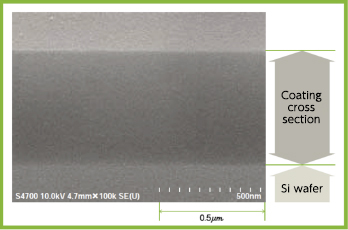| Features | Forms a thick coating |
|---|---|
| Catalyst | Amine-based |
| Type of silazane | Undisclosed |
| Concentration | 2 / 1% |
| Solvent | DBE |
- FE News»
- PPS News»
- Jun. 23, 2025
- Notice of Specification Change for ECHELON Zen-Xero Series Maintenance Bags
- Oct. 31, 2024
- [News Release R-1020] Release of "ECHELON Zen-Xero DYNAMIX”
- May. 15, 2024
- [News Release R-1019] Release of "ECHELON Ver.3.0”
- Oct. 02, 2023
- [News Release R-1018]Compound that achieves a genuine finish Full Renewal of “KATANA” Series
- Jun. 27, 2023
- [News Release] A final finishing compound that achieves a beautiful wet gloss. "KATANA DARK-SHOT" is Released.
TRESMILE (polysilazane) Hybrid Type
A balance of hardness and flexibility
Originally, inorganic polysilazanes provided very high coating hardness, but also had very low coating thickness. At the time, the organic type was still under development. It could provide high thickness, but only low hardness, making it unsuitable for use on its own at that stage. The hybrid type solves this by combining both types to draw out the advantages of each.

The formula achieves a balance between the hardness of the inorganic type and the thickness and flexibility of the organic type.
Forms a coating with moderate thickness
Coating thickness is a key factor in the coating's performance and beauty. The organic polysilazanes in the hybrid type enable the product to be applied at a high concentration that would be difficult with the inorganic type, resulting in superb coating thickness. Furthermore, by utilizing the flexibility of the organic type and the high hardness of the inorganic type, the hybrid type greatly improves on what was the weak point of polysilazane coatings: susceptibility to stains immediately after application.
Excellent ease of use
These inorganic type products use perhydropolysilazane (PHPS), which is widely recognized as a pioneer in polysilazane coatings.

As you can see, the coating is dense and highly uniform.
Hybrid Type product list
Organic Type
The inorganic and organic types differ in the type of molecule attached to the Si-N backbone. The inorganic type only has H molecules, while the organic type has CH3 methyl groups. The main consequence of this difference in structure is that the inorganic type forms a fully glass coating with hydrophilic properties, while the organic type conversely forms a water repellent coating due to the methyl groups on the extremities of its structure.
In addition to the differences in structure, each type of polysilazane is distinguished by name. The inorganic type is called PHPS (perhydropolysilazane), while the organic type is called MHPS (methylhydropolysilazane).
Inorganic Type
The inorganic type forms a fully glass coating, which provides a very high level of hardness. On the other hand, due to its delicacy, it cannot be used at high concentrations, which results in a very thin coating. Meanwhile, the organic type is somewhat inferior to the inorganic type in terms of coating hardness, but has better ease of use and stability. Furthermore, it is highly practical at high concentrations, which enables high coating thickness to be achieved. For the hybrid type, we developed an optimized formula by analyzing how to balance the two types to draw out the strengths of each.



















































